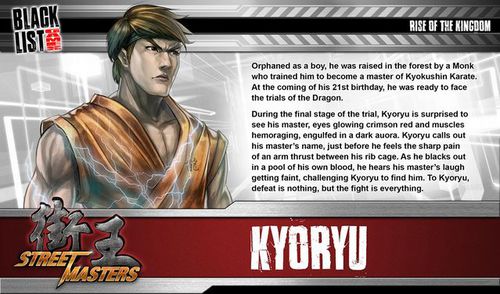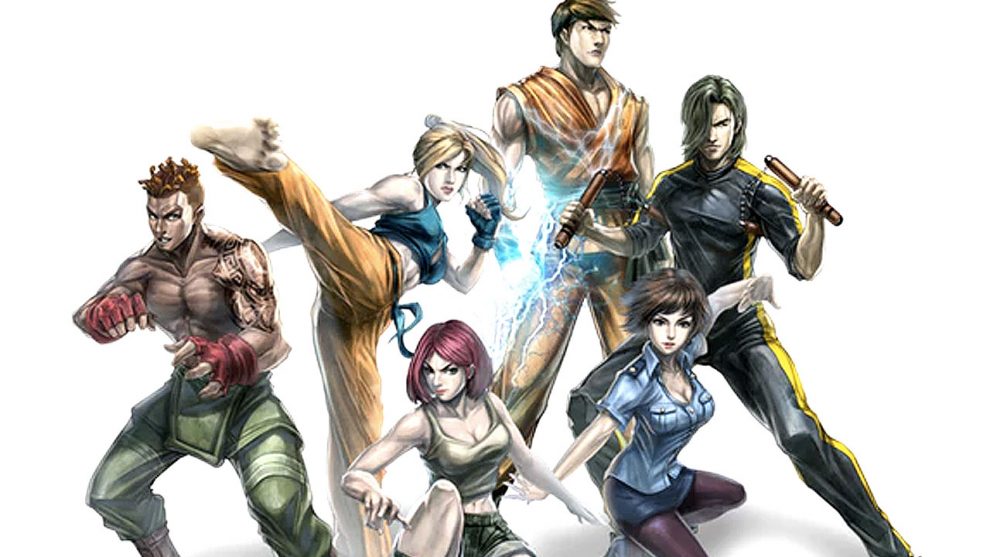Sherman, set the Wayback Machine to 1988. Northridge, California. The 7-11 just 4 blocks from my house, a place where every quarter I would scrounge would find its way into Street Fighter. If you’re not familiar with the ritual, it went something like this: neat rows of quarters marking you had ”next”, cheering your friend as they jump, kick and punch their way to greatness, and the smell of Slurpees and cigarettes wafting about. Being a scrawny, pacifistic 12 year old, this was the one sure way I knew I would be able to kick some butt (albeit digitally). It was a thrill, and by golly it was amazing.
Now, Sherman, bring us to about a year ago. The Sadler Brothers, Brady and Adam (designers of many well known games such as Descent, Warhammer Quest: The Adventure Card Game, and Star Wars: X-Wing), run a Kickstarter for Street Masters: Rise of the Kingdom. I didn’t know about it at the time; somehow it completely passed me by. But a lot of people saw something special in it, a lot of folks voted with their wallets and saw the stretch goals grow, and in the past couple of months, it finally arrived in the hands of many excited gamers.
First Hit
I can’t claim I was waiting with the anticipation that so many folks who excitedly gave their money were, as I honestly had very little knowledge of this game prior to setting it on my table to play. There have been a lot of games I’ve had the pleasure (and some displeasure) of playing over the years that I’ve really gotten so much joy out of playing. And then came Street Masters, and it hit. HARD.
Instead of an overly detailed description of the complexities of this game (and there are some incredibly detailed and dense mechanics at work here), I’m going to cover this contender for my GOTY for 2018 in broad strokes.

Round One
Street Masters is an homage to the fighting games we loved in the 80s, a co-op game with 1-4 players, pitting a band of Heroes against various factions. Consisting of multiple rounds of combat, players engage in turn based combat against the Boss of each faction, along with their respective minions.

Each player selects the hero they wish to play, represented by both a miniature to be placed on the map tile and a Character Card detailing their abilities, health, and the types of damage the player can deal (Punch, Kick, Grapple). There are two states a character can be: Charging and Charged. Each character requires a different value (power) to become fully charged. Think of it like a combo bonus in Street Fighter. While the character is powerful whilst charging, when they are Charged, their attacks deal more damage with more special effects.
Players agree on which Enemy they wish to play against, select that respective deck, and locate the Boss Character Card and miniature. Similar to the Character Cards, the Boss Cards indicate the health (usually 20), the faction to which the Boss belongs, the attack value (number of dice rolled), and some flavor text that describes each Boss’ special ability. These range from extra defense to more attack power and they can brutally sway the game so always keep these in mind!
And every Faction and Boss has its minions, of course , represented by a Card and Miniature. Each game usually begins with a set number of minions and bosses on the board, but as the game progresses, the sheer number of enemies on display can seem (awesomely) overwhelming.
Once you’ve selected your heroes and villains, you choose the stage (map tile) on which this battle will be waged. Each stage has its own specific objectives, events, and loot and every Hero has its own respective Story deck (if you choose to play). The Story deck is a light campaign that can connect multiple games, and is not required to get the most enjoyment but adds a fun layer of connectivity. Combined with the varying events specific to the stage, the game had great variety and a high replayability factor. Street Masters has 6 unique fighters, 8 stages, and 4 factions to choose from. So how does it all come together?

Round Two
Once you’ve set the stage (literally and figuratively), you can dive in. The game is simple in essence: kill the bad guys, get the loot, prevail. But if it were as simple as the NES adaptation of Street Fighter, would you really want to spend the money to play this game? Of course not! Gameplay is broken up into rounds, and the game ends when either the Heroes prevail or the VIllains triumph. There are no counters, no victory points to obtain; just a varying number of enemies to pummel, battles to fight, and levels to survive intact.
Each player has 4 phases for their specific turn:
- Threat: draw an enemy card (this could be single or multiple minions, depending on the faction) and refresh any cards exhausted from previous turns (abilities, power-ups, etc)
- Act: the player can play one of the cards they drew from their starting deck, move 3 spaces, and perform one action (defend against an impending enemy attack, sprint 3 additional spaces, interact with any card in play, or play a card that has already been played in a previous turn)
- React: activate nearby enemies and attack, or move towards the player(s)
- Draw: the player draws 1 card from their deck into their hand for the next turn
At first it might feel as if there’s much going on, having to understand the order of events, the actions available in each turn, and how the enemies react to the actions taken by the players. But once a few rounds are down, it becomes almost like second nature. While I don’t like to be the one to say “Just play it, you’ll see…”, honestly…well, you know where this is going. After each player’s turn, the Enemy takes their turn: bosses move, nearby minions attack or retreat, and new minions spawn if the cards drawn call for it.
In addition to the player and the Enemy, we have the Stage Turn. Each stage is almost like its own character in the game. They have their unique cards that are played, and can turn the tide against you in the blink of an eye. When you think you’ve got the drop on the Boss and have their minions down, 3-4 more minions may start appearing until you’re like Neo fighting the 1000 Agent Smiths in the Matrix Reloaded. Let that be the last time I ever reference The Matrix Reloaded.

Round Three
I’ve read a number of reviews about combat in this game in which dice and randomness are discussed in great detail. In my opinion the combat is really quite simple (and elegant). Each die face has a damage amount (represented by a NEAR EXPLOSION OF AWESOMENESS; sorry, I like POW effects) that you deal, or none if you roll a blank face. To attack, you roll the appropriate number of dice, and let fate take her course.
You can make an argument about why dice and randomness can really sink a game, and in some games die rolls can just end up in a never-ending abyss of bad luck, but that’s not the case here. Even if you roll perfect dice with that awesome combination of a card that gives you the upper hand, the chances are you still may end up dying or getting beaten within an inch of your life.
To me, this is the best part. You can get pushed to the limit where you genuinely do not know if you are going to survive the round, and the next draw or roll may make or break you. And that brings us back to the kids hovered around Street Fighter pouring in quarter after quarter fighting a never-ending array of enemies.

Game Over!
With Street Fighter, and ultimately most video games, there are patterns to master; combinations that you know will work, punches you know to avoid, special abilities (HAROUKEN!) which can act as an Achilles heel to a specific opponent. There’s always a way to win, and you’ll know it when you feel it. That’s fun for a while, but after a few months, you stop going to the arcade or it gets replaced by Mortal Kombat (same problems).
Street Masters can be played solo, or with 2 or 3 people. The more people, the more mayhem. Heck, you can even play multiple fighters yourself and have some fights that are completely insane, with 20 enemies on the board, not including the Boss. And it is in these moments you can actually feel your Heroes standing back to back, sweating and breathing hard as they catch their breath before an onslaught of crazies comes at them with everything they’ve got. They look at each other (I swear you can imagine them smile) and POW!and Brady Sadler have clearly made a game they want to play. Not falling into the trap of this mechanism vs that mechanism or whether it’s a Euro, Ameritrash or some label we want to put on a game. It’s incredibly fun, incredibly dynamic, and something I could imagine hitting my table time and again. There are several expansions, with more to come. The interchangeable modular system they’ve come up with is something truly remarkable, bringing real action to board games. I cannot wait to see what these two come up with next.











This is yet another game on my list of games I own, haven’t played and have no idea how to (yet) lol